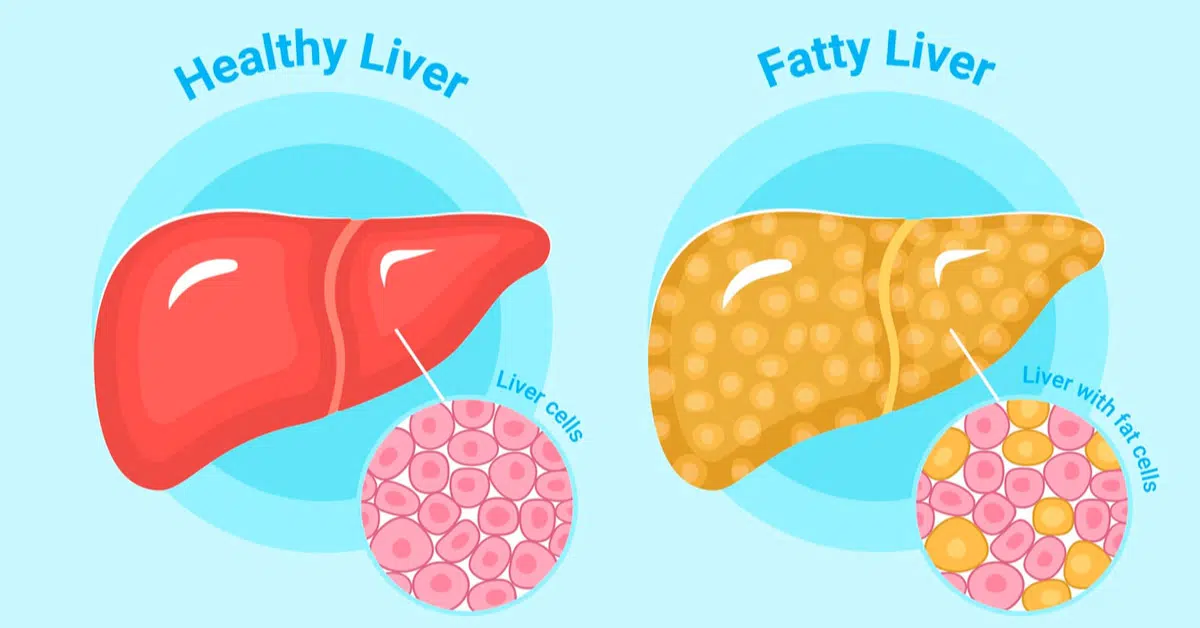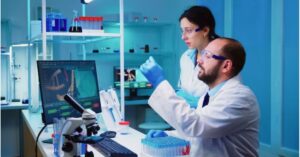Hepatic steatosis, another name for fatty liver disease, is a disorder where fat builds up in the liver cells. While often asymptomatic in its early stages, fatty liver disease can progress to more severe conditions such as non-alcoholic fatty liver disease (NAFLD) and non-alcoholic steatohepatitis (NASH). Understanding the symptoms of fatty liver is crucial for early detection and timely intervention to prevent complications.
Also Read: 9 best Ways to Reduce childhood obesity in 2024
What Causes Fatty Liver?
The development of fatty liver disease is often linked to lifestyle factors such as obesity, insulin resistance, high cholesterol, and type 2 diabetes. Excessive alcohol consumption is also a common cause of fatty liver disease, known as alcoholic fatty liver disease (AFLD). Additionally, certain medications, viral hepatitis, and genetic factors can contribute to the development of fatty liver.
What is the first stage of fatty liver?
The first stage of fatty liver disease is known as simple fatty liver or hepatic steatosis. In this stage, excess fat accumulates in the liver cells, but there is little to no inflammation or damage to the liver tissue. Simple fatty liver often does not cause symptoms and is typically diagnosed incidentally during medical tests or imaging studies performed for other reasons. While simple fatty liver itself may not lead to serious complications, it can progress to more severe stages of fatty liver disease, such as nonalcoholic steatohepatitis (NASH), which involves inflammation and liver damage. Therefore, early detection and lifestyle changes are important for preventing the progression of fatty liver disease.
How do you detect a fatty liver?
Symptoms of Fatty Liver
- Fatigue:
One of the most common symptoms of fatty liver is persistent fatigue and weakness, even after adequate rest. This can be attributed to the liver’s reduced ability to function properly due to the accumulation of fat.
- Abdominal Pain:
Some individuals with fatty liver disease may experience discomfort or pain in the upper right abdomen, where the liver is located. This pain can range from mild to severe and may worsen after eating fatty or fried foods.
- Swelling in the Abdomen:
As fatty liver disease progresses, fluid may accumulate in the abdomen, causing swelling and distension. This condition, known as ascites, can make the abdomen feel tight and uncomfortable.
- Jaundice:
In advanced stages of fatty liver disease, jaundice may develop, causing the skin and whites of the eyes to appear yellowish. Jaundice occurs when the liver is unable to properly metabolize bilirubin, a yellow pigment produced during the breakdown of red blood cells.
Is fatty liver painful?
The fatty liver itself typically doesn’t cause pain. In its early stages, fatty liver disease often presents no symptoms at all. However, as the condition progresses, it can lead to inflammation and scarring of the liver (a condition known as nonalcoholic steatohepatitis or NASH), which may cause discomfort or pain in the upper right side of the abdomen. Additionally, if complications such as liver cirrhosis develop, individuals may experience symptoms such as abdominal pain, swelling in the abdomen, fatigue, weakness, and jaundice (yellowing of the skin and eyes). It’s important for individuals experiencing any persistent or severe abdominal pain or other symptoms to seek medical attention for proper evaluation and management.
Complications of Fatty Liver
Untreated fatty liver disease can lead to serious complications, including liver cirrhosis, liver cancer, and liver failure. Cirrhosis is a progressive scarring of the liver tissue, which impairs liver function and can eventually result in liver failure. Liver cancer, particularly hepatocellular carcinoma (HCC), is also a potential complication of fatty liver disease, especially in individuals with advanced liver damage.
What is a fast way to cure a fatty liver?
There isn’t a “fast” cure for fatty liver disease, as it typically develops over time due to lifestyle factors such as poor diet, lack of exercise, and obesity. However, making certain lifestyle changes can help improve the condition and prevent further liver damage.
- Healthy Diet: Adopting a balanced and nutritious diet is crucial. Avoid excessive alcohol consumption, as it can exacerbate liver damage.
- Regular Exercise: Engage in regular physical activity to help reduce liver fat and promote overall health. This can include activities such as brisk walking, cycling, swimming, or aerobics.
- Weight Management: If you’re overweight or obese, losing weight gradually through a combination of healthy eating and exercise can significantly reduce liver fat. Even a modest weight loss of 5-10% of your body weight can have beneficial effects on liver health.
- Avoidance of Toxins: Minimize your exposure to environmental toxins and medications that can harm the liver. Follow your healthcare provider’s recommendations regarding the use of prescription and over-the-counter medications, and avoid exposure to toxic chemicals whenever possible.
- Regular Medical Monitoring: Stay in regular contact with your healthcare provider for monitoring and management of your condition. They may recommend periodic blood tests, imaging studies, or other evaluations to assess liver function and disease progression.
Prevention and Management
Preventing and managing fatty liver disease involves adopting a healthy lifestyle and addressing underlying risk factors. This includes maintaining a balanced diet low in saturated fats, sugar, and processed foods, engaging in regular physical activity, maintaining a healthy weight, limiting alcohol consumption, and managing underlying conditions such as diabetes and high cholesterol. Additionally, regular medical check-ups and screening tests can help detect fatty liver disease in its early stages, allowing for timely intervention and treatment.
If you experience persistent fatigue, abdominal pain, swelling in the abdomen, or jaundice, consult a healthcare professional for further evaluation and management. By adopting a healthy lifestyle and addressing underlying risk factors, you can reduce your risk of developing fatty liver disease and maintain optimal liver health.




